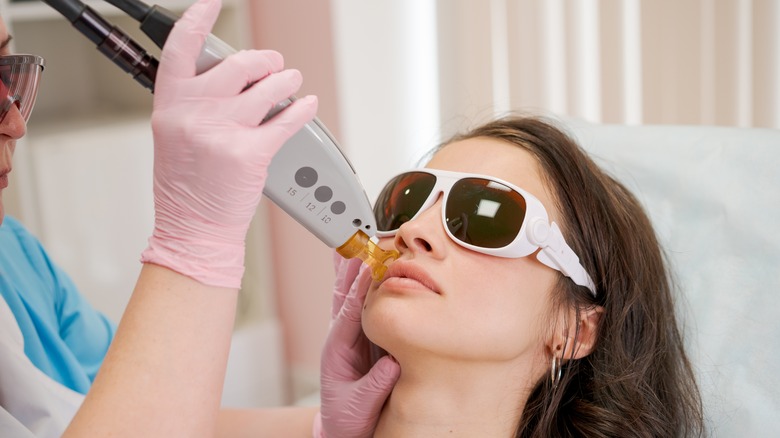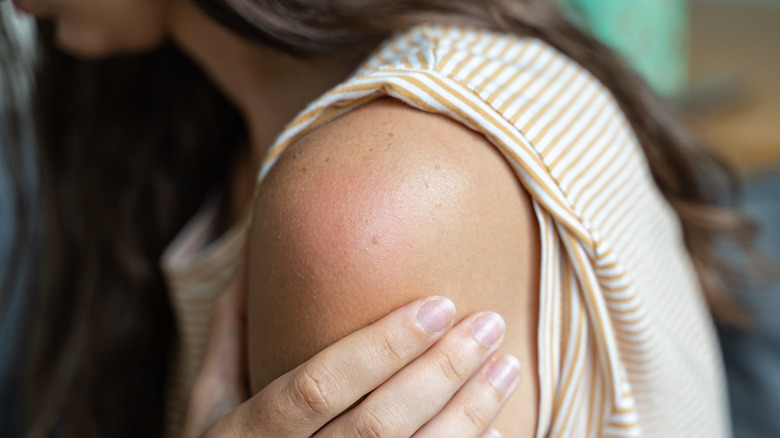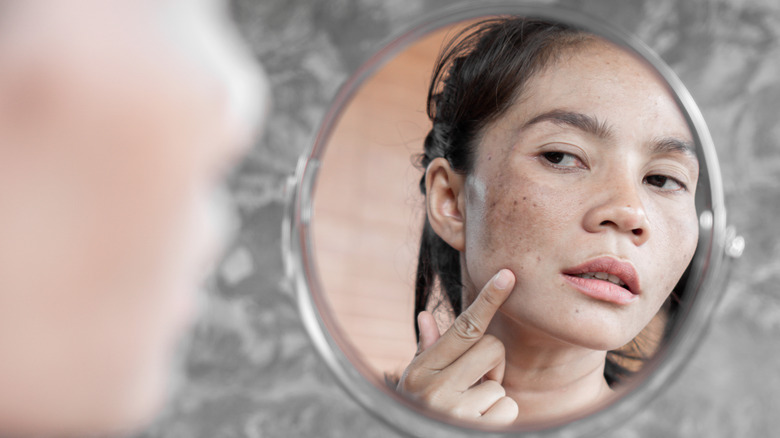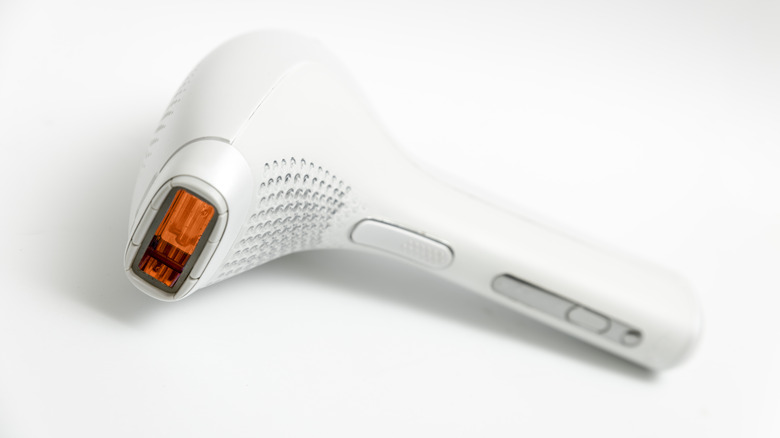Laser Hair Removal Facts Every Woman Should Know
Let's face it, navigating hair removal can be a real pain for women. After all, buying countless shaving sticks and hair removal creams can get tiring easily, while enduring the pain from waxing is simply no fun. If you're after smooth skin minus all the pain, bumps, and cuts, you may have considered a more permanent fix like laser hair removal to keep your unwanted body hair at bay. But before you rush to book your appointment, there are a few things you should know about the beauty procedure.
Laser hair removal is a non-invasive medical procedure that uses concentrated light beams emitted from a laser to remove unwanted hair, according to the American Society of Plastic Surgeons. The popular treatment keeps hair from regrowing by targeting the melanin in the hair, which absorbs light from the laser, and, in turn, damages the hair follicles and prevents regrowth (via Mayo Clinic). While demand for the treatment has been predicted to continue increasing over the coming years (per GlobeNewswire), the procedure comes with its own set of risks and side effects that every woman should be aware of. Lucky for you, we've compiled a list of everything you need to know about laser hair removal.
The procedure is long-lasting but not permanent
First things first, is laser hair removal permanent? Unfortunately, the answer is no. According to Derrow Dermatology, while laser hair removal is effective in reducing hair by about 15 to 30% per session, it is not permanent. This is because your individual hair follicles all have their own stage of growth. Zapping your hair follicles does damage and stunts the growth of hairs in their active cycle that are responsible for producing pigment which gives your body hair its color (per Perfect Skin Center). However, hair follicles that are in the inactive or dormant stage won't be damaged, which means that the laser won't impact them. So, even though the hairs in the active stage are temporarily eradicated, the procedure is not permanent.
You might be disappointed to learn that even laser hair removal won't keep your unwanted hair away permanently. However, the good news is that even though some hair can grow back, the regrowth is a lot lighter and less noticeable for most people who undergo laser hair removal (via Medical News Today). Also, continuous treatments of zapping the hair follicles can help you achieve long-lasting results.
You'll need multiple sessions to achieve desired results
If you're considering laser hair removal, you should know that it takes more than one appointment to be hairless. In fact, according to the Mayo Clinic, the process on average takes anywhere between two to six appointments spread out over the course of a few weeks. However, this depends on the area of hair you're getting removed. For instance, since hair grows rather quickly on your upper lip, laser appointments for this area don't need to be spread out as much as an area of slower hair growth like the back.
With every new session, you should be seeing less and less hair in the areas that you're targeting. This is mainly because having these areas continuously lasered ensures that the damaged hair follicles don't regenerate, and also allows you to target new hair follicles that were previously inactive or dormant (via Healthline). With each additional appointment, you will also likely see more hair reduction and be able to better maintain your hairless look. It's crucial to remember that everyone's hair is different and that some people may need more maintenance than just the initial round of appointments in order to have long-lasting results.
It can add up to be a pricy beauty investment
When you think of beauty investments, laser hair removal is one that surely tops the list with extra time saved from shaving and waxing as well as the long-lasting results of smooth hairless skin. According to the American Society of Plastic Surgeons, the average cost of laser hair removal is around $389 per session. However, this number can be much higher, with the most expensive treatments costing $1,600 per session (via GoodRx Health), depending on the qualification of the person performing the procedure as well as the location.
Yet, the real question is — how much are you willing to invest to have your body hair gone? Given that the beauty treatment is not just a one-time payment and that most health insurance companies don't cover the cost of laser hair removal (per Forbes Health), the hair removal method can quickly add up. It's also worth noting that this cost can differ depending on the area of your body that you decide to get lasered, according to Forbes, with larger areas like your legs costing more than smaller ones. Yet, according to survey findings published in the United Press International (UPI), women in the U.S. spend over $10,000 over the course of their lives on hair removal products like razors or shaving and hair removal creams. So, you may actually end up saving more money with a long-lasting investment like laser hair removal in the long run.
Following your pre-treatment instructions is extremely important
Here's the secret to maximizing the benefits of your laser hair removal appointment: preparation. Listening to all the instructions and advice of the expert performing your procedure is key to warding off any unwanted side effects while also making sure that the treatment is suitable for you. To start, you should consult your laser specialist to see if your hair is suitable to get lasered and find out how many appointments you'll need (via American Academy of Dermatology Association). It's also important to list all of the medications that you are using as well as any health concerns.
Your pre-treatment instructions, according to Body Details, will mainly advise you to stop removing hair from the area you want to get lasered and avoid bleach for at least four to six weeks before your appointment. You'll also want to avoid putting on any makeup or thick creams before your appointment and limit sun exposure or tanning as these can interfere with the laser treatment and stand in the way of getting your ideal results.
It might hurt depending on your pain tolerance
While the procedure isn't supposed to be very painful, it can cause discomfort depending on a variety of factors, like the area you're having treated, the power of the laser you're given, and your hair texture. For instance, Dr. Manjul Agarwal, a dermatologist at Fortis Hospital Shalimar Bagh, told The Indian Express in an interview that nowadays, the procedure is practically painless, given that proper parameters are involved. She explained that this includes cooling the skin before, during, and after treatment to ease the pain. This is easily achieved as many lasers now have a cool tip, and there are also advanced high-speed lasers with a vacuum available that don't cause any pain.
Regardless of high-speed technology, the amount of pain you feel really depends on your pain tolerance. According to Healthline, the best way to explain the sensation of the beauty treatment is to compare it to a mild discomfort felt from a sunburn. To minimize this sensation, your provider can give you a numbing cream. However, if you have particularly sensitive skin, are getting a large area of hair removed, or simply have a low pain tolerance, just know that the procedure could be painful for you.
Redness and swelling after the procedure are common
Don't be alarmed if you find your skin to be red or swollen after your laser hair removal procedure. In fact, the most common minor side effects from the beauty treatment are redness and swelling around the hair follicle for patients (per Froedtert & Medical College of Wisconsin). Similar to how you may get ingrown hairs or bumps after shaving, swelling after a laser hair removal appointment can also occur. This condition is called perifollicular edema, where swelling occurs in the areas where energy is sufficiently absorbed and the hair follicles start to get disabled to prevent hair growth, according to Westerville Dermatology.
The good news is that most swelling, redness, or irritation typically subsides within one to three days (via American Academy of Dermatology Association). While the beauty procedure is known to be minimally invasive, in rare cases where there is persistent swelling, burns, or symptoms of an infection like pus or discolored streaks, you should consult your doctor immediately. According to medwireNews, experts have revealed that laser hair removal can occasionally cause a severe itchy red rash in patients who already suffer from hayfever allergies or asthma. To take precautions, be sure to have a patch test 24 to 48 hours before undergoing laser hair removal and consult your caregiver for any concerns.
The affected skin might appear lighter or darker
If there's one thing all women should know about laser hair removal, it's that your skin color might be affected. This is largely due to your skin reacting to the laser heat or energy, which causes the epidermis of the treated area to become inflamed. When this occurs, the melanocytes, or cells responsible for pigment, are urged to increase melanin production, which can cause lighter or darker spots to appear around the lasered area and last one to two months post-treatment, according to Dr. Michele Green, MD.
Hyper and hypopigmentation are regarded as risk factors for anyone considering laser hair removal (via ScienceDirect). This risk increases even further when inappropriate laser settings are used or inexperienced doctors treat a patient. Board-certified dermatologist Dr. Geeta Yadav told Self that if you have melanin-rich skin, you should be especially careful about the type of laser your provider uses. Some providers like to utilize intense pulsed light technology, which has been known to target melanin in order to destroy hair follicles. Over time this method of treatment can cause darker or lighter spots to appear on deep skin tones.
In order to avoid or minimize this from occurring, be sure to consult your doctor about the type of laser being used and learn about your individual risk factors. Luckily, if discoloration still occurs, there are several topical creams available to help improve the appearance of the skin (via Dr. Michele Green, MD).
Your aftercare will involve avoiding things that may irritate your skin
Since your skin will be extra sensitive after the procedure, it is advised to avoid anything that might further irritate it. The best way to do this is by following the aftercare instructions extremely carefully. Typically, it is advised to shield your skin from the sun to avoid sun exposure. If you are thinking about getting lasered, try to avoid doing so in the summer months as this is when the skin is more exposed to the sun and therefore can easily get irritated or discolored (via USA Today).
Also on the list of things to avoid, you can add hot showers for the first 48 hours, plucking or waxing the hair in between sessions, and thick creams or lotions (via Greatist). It's also a good idea to keep the lasered area cool by using ice packs to reduce swelling and avoiding high-intensity workouts immediately after the beauty treatment. In order to maintain the results of your laser hair removal appointments, be sure to keep up with the necessary aftercare.
Your hair might shed for a while after your procedure
When you get laser hair removal, the process involves damaging the root of the hair in order to prevent growth. Oftentimes, this procedure is followed by your treated hair falling out or shedding in the days following the beauty treatment. While this may be alarming, it is actually a good sign that the treatment is doing its job, per Skin Technique Medical Aesthetics. The reason for this shedding is that the damaged hair is signaling to your body that it is no longer needed, and therefore, falls out over the course of one to three weeks following treatment. Skin Technique also warns that this shedding may appear as blackheads or stubble.
However, don't fret if your hair doesn't fall out right away. Because hair growth occurs in cycles, you will see shedding and reduced hair as time goes on with each additional laser treatment, according to the Mayo Clinic. When shedding does eventually occur, it is recommended that you don't pull out loose hair as this could disrupt the hair growth cycle, and in some cases, even stimulate growth. While waxing and pulling out hair isn't allowed, shaving and exfoliating the area is as doing so can boost shedding and minimize the risk of ingrown hair (via Ruma).
The hair will come back smoother and finer
While laser hair removal can't guarantee that you will have fully hairless skin, it can provide hair that is lighter and thinner (via Mayo Clinic). This is beneficial for clients seeking laser hair removal in the first place as the appearance of your unwanted hair becomes a lot less noticeable and more manageable.
When laser hair removal is performed properly, the procedure will target the rate of hair growth, hair density, and thickness according to StyleCraze. Over time, these results will showcase delayed hair growth and smoother or finer hair. However, if the procedure is not performed properly, paradoxical hypertrichosis can occur, where the hair actually grows back thicker and coarser after laser treatment. However, research findings published in "Dermatologic Surgery" indicate that this is a rather rare and adverse side effect that occurs primarily in the face and neck and in only 0.6% to 10% of patients. Don't let this deter you, as for the majority of patients, the results are typically lighter and easier to manage hair.
Laser hair removal will work better on darker hair
Modern lasers can now accommodate a variety of skin tones and hair colors. However, there are some hair colors that laser treatments work better for. Generally, if you have hair that is darker than your skin tone, then laser hair removal will work better on you (via Vaderma Advanced Laser Skincare).
Laser technology targets the color in your hair follicles to remove hair. According to Body Details, darker colors tend to attract light in the visible light spectrum. Thus, when a laser is aimed at darker hair, it is fairly easy to detect and can quickly get hot and damage the targeted hair. However, this can be a double-edged sword for dark-haired women as this can cause overexposure to damage. To combat this, modern technology now has different wavelengths of lasers that can work on all different skin and hair types to prevent both under and overexposure. This means that even if you have lighter hair, you can still get laser hair removal. Just bear in mind that it may take you more sessions than someone with darker hair to achieve your wanted results (via Infinity Laser Spa).
At-home treatments exist but they may not be safer or more effective
As laser hair removal increases in popularity, we are no longer limited to just getting the treatment done at a doctor's office. Now there are at-home laser hair removal devices available to use at our disposal. The cost of these laser devices is typically only $400 or $500 (per Cleveland Clinic), which is a lot cheaper than booking multiple professional laser appointments. However, just because at-home laser products are available, doesn't mean that they are the safest or even the most effective option.
Not all at-home laser treatments are FDA approved (via Hour Detroit), which means that the safety of these devices is questionable. This is why it is important to be aware of the increased risks of an at-home kit, such as a high burn risk, which is especially possible for people with darker skin. The at-home lasers include true lasers and intense pulsed light lasers, both of which use light to heat the hair follicles and vary only in the wavelength. However, these devices are not nearly as powerful as professional ones (via Cleveland Clinic).
Ultimately, while the choice depends on the person, professional hair removal gives you a bigger bang for your buck, dermatologist Rachel Ward told Cleveland Clinic.
There are health risks to consider
No beauty treatment comes without risks, which may make you think twice about getting laser hair removal in the beginning. Some risks include scabbing, scarring, eye injuries, and inhaling harmful toxins. While these side effects may sound scary, skin irritations like scabbing or scarring only occur if post-treatment instructions are not properly followed or if the skin is left unmoisturized. Eye injuries, on the other hand, are increasingly likely if the hair being lasered is on a person's face. This is why laser hair removal isn't recommended for eyelids, eyebrows, or any area near the eyes (via Mayo Clinic).
Research findings published in "Jama Dermatology" indicate that over 377 chemical compounds are released into the air during laser hair removal, 13 of which are suspected carcinogens, while more than 20 are environmental toxins. According to the study, among these released chemicals is a black plume of smoke that is especially prevalent during laser hair removal and is considered harmful to both humans and animals. This poses the greatest risk for practitioners who are continuously exposed to these chemicals and may need smoke evacuators or masks to ensure personal safety. While patients of laser hair removal should worry more about the topical reactions, it is important to consider all health and environmental risks of the beauty treatment.













